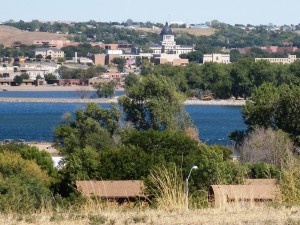» September 24th, 2012
Sentinels in Bronze
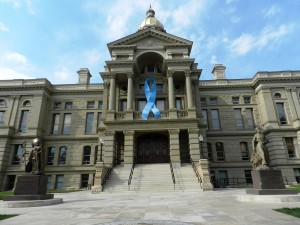 Linda Burton posting from Cheyenne, Wyoming – Esther Hobart Morris and Shoshone Chief Washakie have several things in common. Bronze statues of the two flank the entry to the Wyoming State Capitol, that’s the first thing; and replicas of those statues represent the state in National Statuary Hall in Washington, DC. The stories told about them have elevated them to the status of legends; larger-than-life icons that changed the world in a flash. But these two were simply orphans who were dealt some hard knocks, and who faced them in the best way they could. I find no record that their paths ever crossed, but they shared the same space in time, living through most of the turbulent 1800’s, and they shared minority status as the law and the social climate related to them. A woman, and an American Indian; exactly what did these two people face, and how did they respond? » read more
Linda Burton posting from Cheyenne, Wyoming – Esther Hobart Morris and Shoshone Chief Washakie have several things in common. Bronze statues of the two flank the entry to the Wyoming State Capitol, that’s the first thing; and replicas of those statues represent the state in National Statuary Hall in Washington, DC. The stories told about them have elevated them to the status of legends; larger-than-life icons that changed the world in a flash. But these two were simply orphans who were dealt some hard knocks, and who faced them in the best way they could. I find no record that their paths ever crossed, but they shared the same space in time, living through most of the turbulent 1800’s, and they shared minority status as the law and the social climate related to them. A woman, and an American Indian; exactly what did these two people face, and how did they respond? » read more
» September 22nd, 2012
It’s A Fine Fall Day
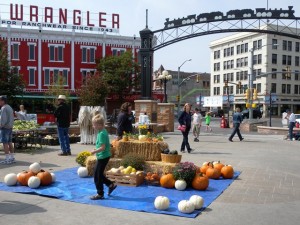 Linda Burton posting from Cheyenne, Wyoming – Fish and ducks and geese didn’t scurry, and there was no fringe on our top; but a Trolley ride on the first day of fall is a mighty fine way to spend a day. Autumn began in Cheyenne at precisely 8:49 AM this morning and I was ready for the Farmers Market at Depot Plaza just about that time. Pumpkins and apples on display; mums in pots; pies and peppers and fresh-baked zucchini bread; the mood was set, framed by the two things that define Cheyenne – trains, as depicted in the arch overhead, and ranchwear, for sale across the street. With a slice of that zucchini bread in hand, I headed for the Trolley, parked right outside the gate. The Trolley Passport in my hand promised a “fully narrated historic tour that captures the lively character of days gone by.” I’m ready for the ride. » read more
Linda Burton posting from Cheyenne, Wyoming – Fish and ducks and geese didn’t scurry, and there was no fringe on our top; but a Trolley ride on the first day of fall is a mighty fine way to spend a day. Autumn began in Cheyenne at precisely 8:49 AM this morning and I was ready for the Farmers Market at Depot Plaza just about that time. Pumpkins and apples on display; mums in pots; pies and peppers and fresh-baked zucchini bread; the mood was set, framed by the two things that define Cheyenne – trains, as depicted in the arch overhead, and ranchwear, for sale across the street. With a slice of that zucchini bread in hand, I headed for the Trolley, parked right outside the gate. The Trolley Passport in my hand promised a “fully narrated historic tour that captures the lively character of days gone by.” I’m ready for the ride. » read more
» September 18th, 2012
No Shy Anns Here
 Linda Burton posting from Cheyenne, Wyoming – When you think of women of the American West, do Annie Oakley and Calamity Jane come to mind? Back in the 50’s Doris Day portrayed both of them in film, and in song; women who seemed to have more fun than hard times. Perhaps you temper that “buttons and bows, sharp-shootin” image with the knowledge of an ancestor whose hardships you’ve heard in stories handed down; women who buried children along the trail and struggled in a land that offered few favors. The truth is somewhere in there, and over on West 17th Street in Cheyenne you can learn about those truths in Cowgirls of the West Museum, run by modern-day women of the west who not only preserve the stories of the past, but who continue to shape the Cheyenne of today. I found another interesting “western woman” influencing the Cheyenne
Linda Burton posting from Cheyenne, Wyoming – When you think of women of the American West, do Annie Oakley and Calamity Jane come to mind? Back in the 50’s Doris Day portrayed both of them in film, and in song; women who seemed to have more fun than hard times. Perhaps you temper that “buttons and bows, sharp-shootin” image with the knowledge of an ancestor whose hardships you’ve heard in stories handed down; women who buried children along the trail and struggled in a land that offered few favors. The truth is somewhere in there, and over on West 17th Street in Cheyenne you can learn about those truths in Cowgirls of the West Museum, run by modern-day women of the west who not only preserve the stories of the past, but who continue to shape the Cheyenne of today. I found another interesting “western woman” influencing the Cheyenne 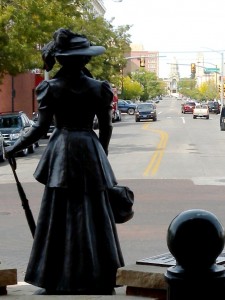 of today, and in fact the art scene around the world; it’s Veryl Goodnight, artist extraordinaire. I found her work in front of the Old West Museum on North Carey Avenue; her bronze statue of a woman by a wagon wheel is entitled No Turning Back; Veryl’s poem is inscribed below; a touching tale of women who “stored their silk dresses and donned calico.” In front of the Historic Depot on West 15th is Cheyenne’s latest Goodnight acquisition: a woman standing with umbrella in one hand and handbag in the other, as though she just stepped off the train. A New Beginning is the title; she faces Capitol Avenue with the state capitol at the far end. A meaningful view? » read more
of today, and in fact the art scene around the world; it’s Veryl Goodnight, artist extraordinaire. I found her work in front of the Old West Museum on North Carey Avenue; her bronze statue of a woman by a wagon wheel is entitled No Turning Back; Veryl’s poem is inscribed below; a touching tale of women who “stored their silk dresses and donned calico.” In front of the Historic Depot on West 15th is Cheyenne’s latest Goodnight acquisition: a woman standing with umbrella in one hand and handbag in the other, as though she just stepped off the train. A New Beginning is the title; she faces Capitol Avenue with the state capitol at the far end. A meaningful view? » read more
» September 17th, 2012
First and Foremost
 Linda Burton posting from Cheyenne, Wyoming – Wyoming may be the 50th state in terms of population, but it lays claim to an awful lot of FIRSTS. It is home to the first National Park in the United States (in fact, the world). The beloved Yellowstone National Park, in the northwest corner of the state, was created by an act of Congress in 1872. Wyoming also has the first National Monument – Devils Tower, in the northeast corner of the state; designated by President Theodore Roosevelt in 1906. The first National Forest – the Shoshone – and the first ranger station – the Wapiti, in that forest – were created in 1891. The first business west of the Missouri River was established by fur traders William Sublette and Robert Campbell in 1834, near Fort William in Wyoming. And Wyoming was the first state to have a county public library system. The Laramie County Library was established in 1886, when Wyoming was still a territory. Located in the capital city of Cheyenne and still in existence today, it is the longest continually operating county library system in the United States. » read more
Linda Burton posting from Cheyenne, Wyoming – Wyoming may be the 50th state in terms of population, but it lays claim to an awful lot of FIRSTS. It is home to the first National Park in the United States (in fact, the world). The beloved Yellowstone National Park, in the northwest corner of the state, was created by an act of Congress in 1872. Wyoming also has the first National Monument – Devils Tower, in the northeast corner of the state; designated by President Theodore Roosevelt in 1906. The first National Forest – the Shoshone – and the first ranger station – the Wapiti, in that forest – were created in 1891. The first business west of the Missouri River was established by fur traders William Sublette and Robert Campbell in 1834, near Fort William in Wyoming. And Wyoming was the first state to have a county public library system. The Laramie County Library was established in 1886, when Wyoming was still a territory. Located in the capital city of Cheyenne and still in existence today, it is the longest continually operating county library system in the United States. » read more
» September 16th, 2012
Look What The Wind Blew In
 Linda Burton posting from Cheyenne, Wyoming – “Does the wind blow here all the time?” brought me a loud “Yes!’ from the restaurant hostess in answer. I’d just walked across the parking lot for my Sunday evening dinner with shoulders hunched against the strong winds, my jacket zipped to the top. Yesterday it tried to blow the limbs off my Christmas cactus as I unloaded the car; I ran fast to get inside the first of the double doors. And the doors have signs instructing “High Winds Please Pull Door Shut.” Even the little card-swiper devices for unlocking the doors have protective lids over them; you have to lift in order to insert the card. I need to find out about the wind fences I saw alongside the freeway, I’m thinking, remembering mile after mile of curved wooden rails that seem to be connected to nothing, but are everywhere, on the windward side of the road. That was one clue, for sure. And after all, I know Cheyenne sits high on the mountain plains; elevation 6,098 feet, the second-highest of the 50 capital cities. I picked up a brochure before I sat down. » read more
Linda Burton posting from Cheyenne, Wyoming – “Does the wind blow here all the time?” brought me a loud “Yes!’ from the restaurant hostess in answer. I’d just walked across the parking lot for my Sunday evening dinner with shoulders hunched against the strong winds, my jacket zipped to the top. Yesterday it tried to blow the limbs off my Christmas cactus as I unloaded the car; I ran fast to get inside the first of the double doors. And the doors have signs instructing “High Winds Please Pull Door Shut.” Even the little card-swiper devices for unlocking the doors have protective lids over them; you have to lift in order to insert the card. I need to find out about the wind fences I saw alongside the freeway, I’m thinking, remembering mile after mile of curved wooden rails that seem to be connected to nothing, but are everywhere, on the windward side of the road. That was one clue, for sure. And after all, I know Cheyenne sits high on the mountain plains; elevation 6,098 feet, the second-highest of the 50 capital cities. I picked up a brochure before I sat down. » read more
» September 15th, 2012
King of Coal
 Linda Burton posting from Cheyenne, Wyoming – Mile-long coal trains followed me into Cheyenne yesterday, a sight to see. I’m back to mountains now, the Laramies. Natures foothills were the dark green backdrop for the distant man-made slivers moving south across my westward view. Blue sky and silver trains; I stopped counting at twelve. The tracks merged closer to the freeway as I neared the city; they converged across the street from my hotel. Through the night I heard the muffled rumblings of the trains; from the breakfast room this morning I watched them roll. Where does this coal come from, I wanted to know, and where is it going? Wyoming coal. » read more
Linda Burton posting from Cheyenne, Wyoming – Mile-long coal trains followed me into Cheyenne yesterday, a sight to see. I’m back to mountains now, the Laramies. Natures foothills were the dark green backdrop for the distant man-made slivers moving south across my westward view. Blue sky and silver trains; I stopped counting at twelve. The tracks merged closer to the freeway as I neared the city; they converged across the street from my hotel. Through the night I heard the muffled rumblings of the trains; from the breakfast room this morning I watched them roll. Where does this coal come from, I wanted to know, and where is it going? Wyoming coal. » read more
» September 11th, 2012
A Norman Rockwell Afternoon
 Linda Burton posting from Pierre, South Dakota – “Here come the flags!” The little boy standing beside me stared big-eyed; his father coached him with enthusiastic phrases. “Just look at that! Flags, and the band!” I felt the enthusiasm myself; the high-stepping band drew all eyes towards them as they marched center street; the shower of candies flung from the floats brought squeals as kids scrambled to pick up the treasured sugar treats. It’s
Linda Burton posting from Pierre, South Dakota – “Here come the flags!” The little boy standing beside me stared big-eyed; his father coached him with enthusiastic phrases. “Just look at that! Flags, and the band!” I felt the enthusiasm myself; the high-stepping band drew all eyes towards them as they marched center street; the shower of candies flung from the floats brought squeals as kids scrambled to pick up the treasured sugar treats. It’s  Homecoming Week at the high school, and that means, of course, a parade. I had parked the Scion on Missouri and walked to the corner of Pierre Street just as the drums came down the hill. The drums, and the horns; the floats and the firetrucks; the brightly painted vans and the dogs-on-a-leash wearing neckscarves of green, to match their owners shirts. A parade is all about showing off, marching right in front of the world to strut your stuff. A Homecoming Parade is a celebration of spirit; the spirit of the school; the spirit of the town. And the town loves to watch. » read more
Homecoming Week at the high school, and that means, of course, a parade. I had parked the Scion on Missouri and walked to the corner of Pierre Street just as the drums came down the hill. The drums, and the horns; the floats and the firetrucks; the brightly painted vans and the dogs-on-a-leash wearing neckscarves of green, to match their owners shirts. A parade is all about showing off, marching right in front of the world to strut your stuff. A Homecoming Parade is a celebration of spirit; the spirit of the school; the spirit of the town. And the town loves to watch. » read more
» September 10th, 2012
Not A Bad Place To Work
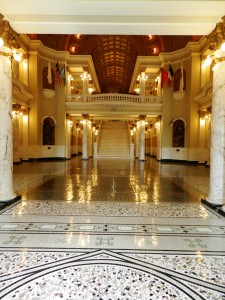 Linda Burton posting from Pierre, South Dakota – I started snapping pictures the moment I walked in the door; the staircase straight ahead, the hallway to the right; the stained glass overhead; the rotunda, the vault, the murals, the flags, the dazzling terrazzo floor. My eyes could not decide just where to stop. It was light and shiny bright, yet colorful and warm; uplifting, can I use that word? I didn’t know which direction to go first; a young woman approached the elevator by the side of the staircase and I began to ask: Is the gallery open? Can I take the elevator all the way up? What is on the floor below? I realized as I gestured that I had the Self Guided Tour Script of the South Dakota State Capitol under my arm; “Oh, I’m sorry!” I said. “I picked this up at the front door, I should slow down and read it. But everything is so pretty I got overawed.” “I know,” she smiled at me and folded her hands across her tummy; she was pregnant and enveloped with that pregnant glow. “I love working in this beautiful place. I look forward to coming inside every morning.” Quite an endorsement for a building, I’d say. » read more
Linda Burton posting from Pierre, South Dakota – I started snapping pictures the moment I walked in the door; the staircase straight ahead, the hallway to the right; the stained glass overhead; the rotunda, the vault, the murals, the flags, the dazzling terrazzo floor. My eyes could not decide just where to stop. It was light and shiny bright, yet colorful and warm; uplifting, can I use that word? I didn’t know which direction to go first; a young woman approached the elevator by the side of the staircase and I began to ask: Is the gallery open? Can I take the elevator all the way up? What is on the floor below? I realized as I gestured that I had the Self Guided Tour Script of the South Dakota State Capitol under my arm; “Oh, I’m sorry!” I said. “I picked this up at the front door, I should slow down and read it. But everything is so pretty I got overawed.” “I know,” she smiled at me and folded her hands across her tummy; she was pregnant and enveloped with that pregnant glow. “I love working in this beautiful place. I look forward to coming inside every morning.” Quite an endorsement for a building, I’d say. » read more
» September 9th, 2012
Just Watch
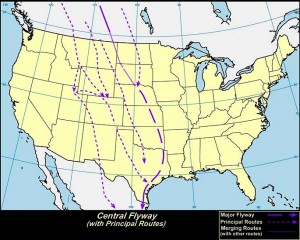 Linda Burton posting from Pierre, South Dakota – It stands to reason. There’s a lake just outside town that stretches clear to North Dakota. The river at the city’s edge is the longest river in the United States. With all that, you’d expect a fair amount of waterfowl would choose to live around Pierre, and it does. Gulls and ducks are common sights; I couldn’t name them myself, but birders have identified
Linda Burton posting from Pierre, South Dakota – It stands to reason. There’s a lake just outside town that stretches clear to North Dakota. The river at the city’s edge is the longest river in the United States. With all that, you’d expect a fair amount of waterfowl would choose to live around Pierre, and it does. Gulls and ducks are common sights; I couldn’t name them myself, but birders have identified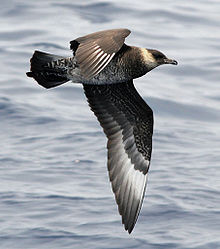 Sabine, Ring-billed and the Black-hooded Bonaparte gulls near Oahe Dam; the list of ducks includes Red-breasted Mergansers, Common Goldeneye, Bufflehead, and assorted little puddle ducks. You might even spot a rare yellow-billed loon, or a Pomerine Jaeger, aka Skua, a very aggressive Arctic bird (right). Because it’s not just the live-ins you get to see around here, South Dakota is “on the route” as millions of birds follow the Central migratory flyway across the state in spring and fall. Paradise for birdwatchers, paradise for birds. » read more
Sabine, Ring-billed and the Black-hooded Bonaparte gulls near Oahe Dam; the list of ducks includes Red-breasted Mergansers, Common Goldeneye, Bufflehead, and assorted little puddle ducks. You might even spot a rare yellow-billed loon, or a Pomerine Jaeger, aka Skua, a very aggressive Arctic bird (right). Because it’s not just the live-ins you get to see around here, South Dakota is “on the route” as millions of birds follow the Central migratory flyway across the state in spring and fall. Paradise for birdwatchers, paradise for birds. » read more
» September 8th, 2012
Across The River
Linda Burton posting from Pierre, South Dakota – From missionaries to movie makers, fur traders to cattle ranchers, expeditionists to archeologists, they have come to Fort Pierre. Fort Pierre lies just across the Missouri River from the capital city of Pierre, but it’s a major crossing, moving you back in time. Literally, right in the middle of the river you change from the Central Time Zone into Mountain Time. And with a little imagination, you can historically go back hundreds of years. Can you imagine the Lakota Sioux living here, with hundreds of tipis and thousands of buffalo spreading over the hills? Can you imagine two brothers from France digging a hole high on a hill above the river in the dark of 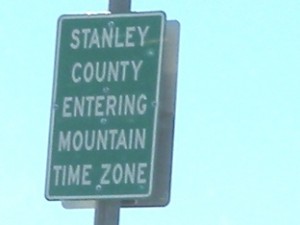 night, and burying a secret? Can you imagine Meriwether Lewis and William Clark stepping ashore to explore the golden hillsides for flora and fauna, documenting the west? You can still see buffalo herds today, and that secret object that was buried high on that hill. You can see artifacts and remnants left by the adventurers of long ago, and you can walk their path. And if your imagination is lacking, you can rent movies that will recreate the scenes before your very eyes. » read more
night, and burying a secret? Can you imagine Meriwether Lewis and William Clark stepping ashore to explore the golden hillsides for flora and fauna, documenting the west? You can still see buffalo herds today, and that secret object that was buried high on that hill. You can see artifacts and remnants left by the adventurers of long ago, and you can walk their path. And if your imagination is lacking, you can rent movies that will recreate the scenes before your very eyes. » read more

